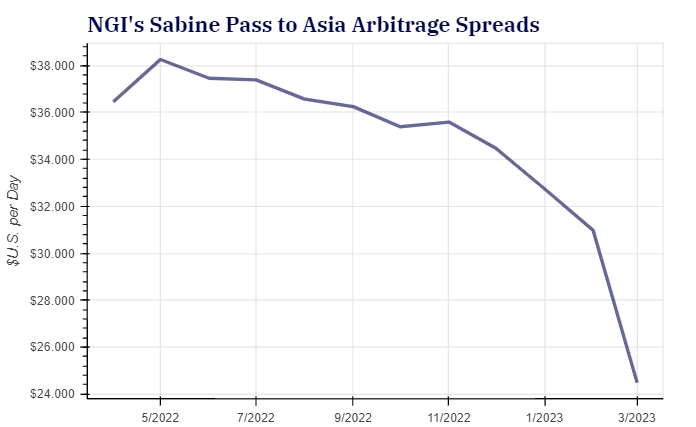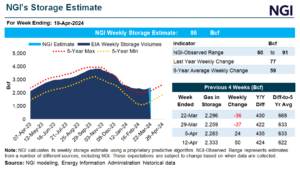LNG | International | LNG Insight | NGI All News Access | NGI The Weekly Gas Market Report
Asian LNG Prices Volatile as War in Ukraine Could Intensify Competition for Cargoes
Spot prices for liquified natural gas (LNG) to be delivered to Asia have taken a volatile swing upward as buyers prepare for a potential tug-of-war with a European continent struggling through a major gas crunch and impacts from the Ukrainian conflict.

Spot Japan-Korea Marker (JKM) prices were assessed at a record $59.672/MMBtu Thursday before taking a dip to an intraday value of $43.40/MMBtu Friday morning.
JKM April futures prices settled at $38.65/MMBtu on Friday, adding more than $5 from the day before. It was the first time in five days Asian futures haven’t followed the Dutch Title Transfer Facility (TTF) price on its upward trajectory.
Dutch futures for LNG to Europe for April closed at nearly $62/MMBtu Friday, breaking the record high previously set in December.
The uncertainty around supplies of natural gas and the competition for LNG cargoes as the Ukrainian crisis escalates has sparked more market volatility for Asia. If market conditions and pressure on Europe from the conflict worsen, there is a chance prices could spike even higher, especially when Asian buyers have to make LNG resupply orders later in the second quarter as they look to fill inventories after winter.
For now, stable flows of contracted gas from Russia and the price-impact on demand has kept buyers from being tempted to overbid, according to analysts from Engie EnergyScan. The firm predicted early Friday that JKM prices would likely fall below the five-day average later in the day or at the beginning of next week if there weren’t further shocks to the market.
But, “with higher Asia JKM spot prices suggesting stronger competition for flexible LNG cargoes,” the firm predicted there may be less reason for buyers to stay their hand in the near future.
Asia has typically netted the most deliveries of U.S. LNG over any other continent. Even with the spike in deliveries across the Atlantic last year, terminals in the United States sent 414.5 cargoes to Asia in 2021 compared to 357.5 to Europe, according to NGI calculations.
Cold winter weather and months of absent spot gas from Russia gave Europe the price advantage over Asia in December. Those high prices also helped pull the JKM further north as countries like Japan dealt with cold snaps and key Asian suppliers saw outages for maintenance.
By January, though, the deluge of diverted LNG helped strike a thin balance between Europe and Asia thanks to a milder winter in China.
Analysts from the Institute for Energy Economics and Financial Analysis (IEEFA) are predicting volatile LNG prices will lead to a repeat of what happened in Asia in 2021, but with perhaps stronger impacts. The group advocates for renewable energy.
IEEFA Energy Finance Analyst Sam Reynolds said evidence shows the competition for cargoes could lead to even greater fluctuations than the year before, which likely means Asian gas-fired generation plants will be underutilized.
It also means that economic growth for much of the continent could be in danger if industrial sectors across Asia are hit with inflating costs or even the kind of energy rationing China saw last October.
“The Russian invasion of Ukraine is likely to exacerbate commodity price volatility, which undermines Asian countries’ economic growth and obstructs the region’s arduous recovery from the COVID-19 pandemic,” Reynolds said in a commentary from IEEFA.
© 2024 Natural Gas Intelligence. All rights reserved.
ISSN © 1532-1231 | ISSN © 2577-9877 | ISSN © 1532-1266 |


